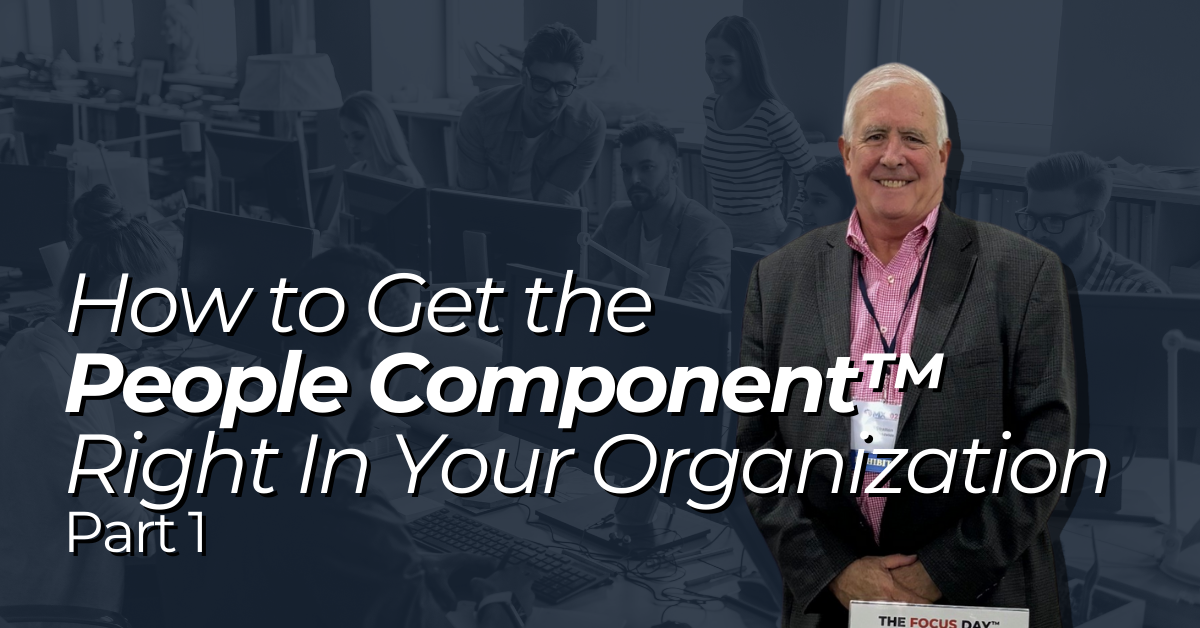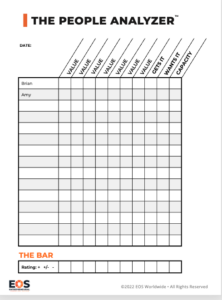
For most organizations, 82% of their issues originate in the People Component of the EOS model®—not having the right people in the right seats. Whenever a leader is dealing with an employee issue, I ask: “Is this a right person or right seat issue?” Occasionally, a person is not a good fit—period; sometimes an individual might be a good fit for the organization but isn’t in the right seat.
Using the EOS People Analyzer™ and the Accountability Chart™ tools together, you can more effectively get to the root of people issues and address them.
I’ve used these two tools with my clients over the years to help them gain clarity about what’s truly at the heart of their employee issues. Though they work together, each one warrants its own moment in the spotlight, so in this article I’ll discuss the People Analyzer and cover the Accountability Chart in my next post.
The first part of getting the right people in the right seats is assessing if you have the right people—employees whose behaviors are consistent with your organization’s three to seven Core Values.
The People Analyzer is a chart for rating your team members on whether they demonstrate alignment with your Core Values.

Use it to list your employees and then give them a +, +/-, or - rating for each Core Value.
Optimally, if you have five Core Values, you’ll want at least three + ratings and two +/- ratings as a minimum bar. If a person scores less than that, they are not likely the right person for your organization—unless they can change their behaviors.
Assessing each individual’s behaviors is critical because even top performers (in terms of their job responsibilities) can create workplace discord—leaving damage in their wake—if their behavior fails to align with your Core Values.
The first step is for the leadership team to define the business’ Core Values and the expected behavior(s) surrounding each one. When leading teams on their EOS Implementation journey, I facilitate this during our second foundational session, which we call Vision Building #1.
Typically the Core Values already exist in the organization, and we facilitate bringing them out and creating clarity around each one.
A Hypothetical Example:
Here are the Core Values for ABC Manufacturing Company and the expected behaviors associated with each one:
Core Value #1: Be Committed to the Company’s, Our Customers’, and Each Other’s Success
Expected Behavior:
Core Value #2: Get the Job Done With Excellence
Expected Behaviors:
Core Value #3: Be a Great Team Player
Expected Behaviors:
Core Value #4: Be Humble, Caring, and Compassionate
Expected Behaviors:
Now we will apply the People Analyzer to John Marino, a key engineer for the business.

As you can see, John’s behavior is inconsistent with the Core Value, “Be a Great Team Player.” His behavior has not been supportive of the team, especially the manufacturing and procurement team members with whom he has initiated arguments and spoken badly of them behind their backs. John’s behavior is disruptive to his fellow team members and is negatively impacting the company’s culture. In this case, John’s manager, the Director of Engineering, coached John on being more self-aware of his behavior and its impact on his fellow employees and had him read, “Emotional Intelligence 2.0.”
Within six months, John’s behavior had dramatically improved and he scored +’s for both the “Be a Great Team Player” and the “Be Humble, Caring, and Compassionate” Core Values. If he didn’t change his behavior, he would have been asked to leave, which would have been painful since he was very competent and GWC’d his engineering seat.
Using the People Analyzer helps ensure everyone in your organization is aligned with your company values and vested in working toward your goals. Moreover, it can lead to a healthier team dynamic and a more harmonious workplace, ultimately improving organizational performance. This tool needs to be included as part of employees’ annual performance reviews.
The tool provides a framework for what we in EOS refer to as “entering the danger,” i.e., engaging in uncomfortable conversations with employees and fellow leaders. Difficult discussions about behavior require courage and a consistent approach. The People Analyzer—particularly when used with the Accountability Chart—builds confidence and opens the door to candid and constructive communication between leaders, managers, and staff.
Want to learn more about how the People Analyzer tool can help you get to the root of your employee issues? Schedule a call with me!
Stay tuned for my next article about how to use the Accountability Chart for ensuring your team members are in the right seats.